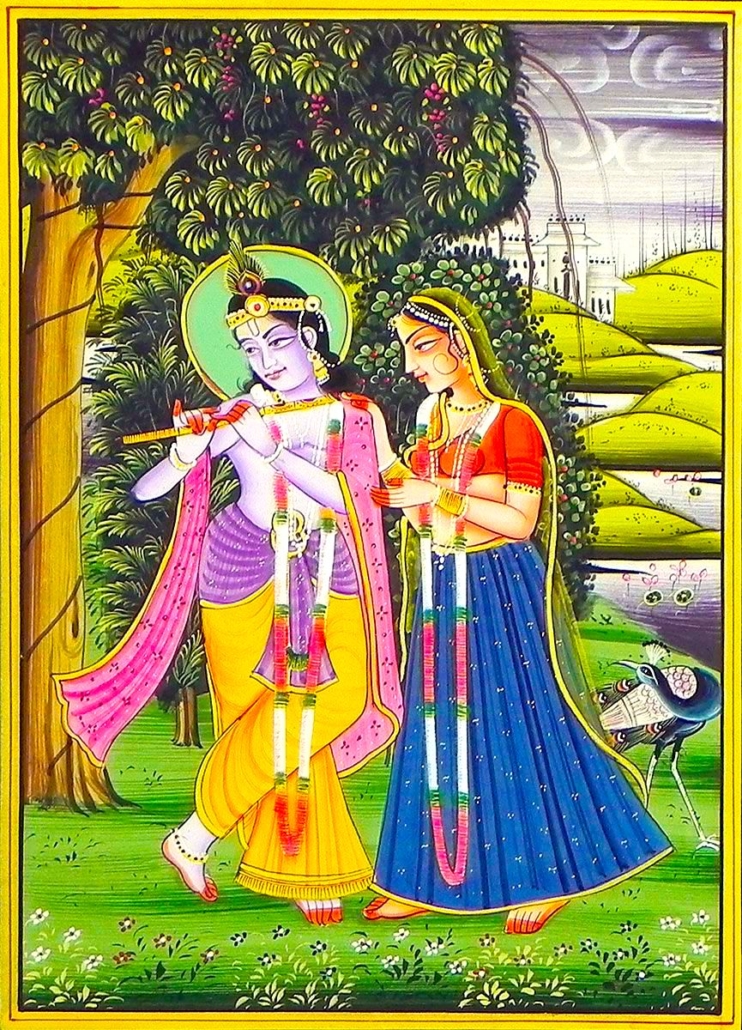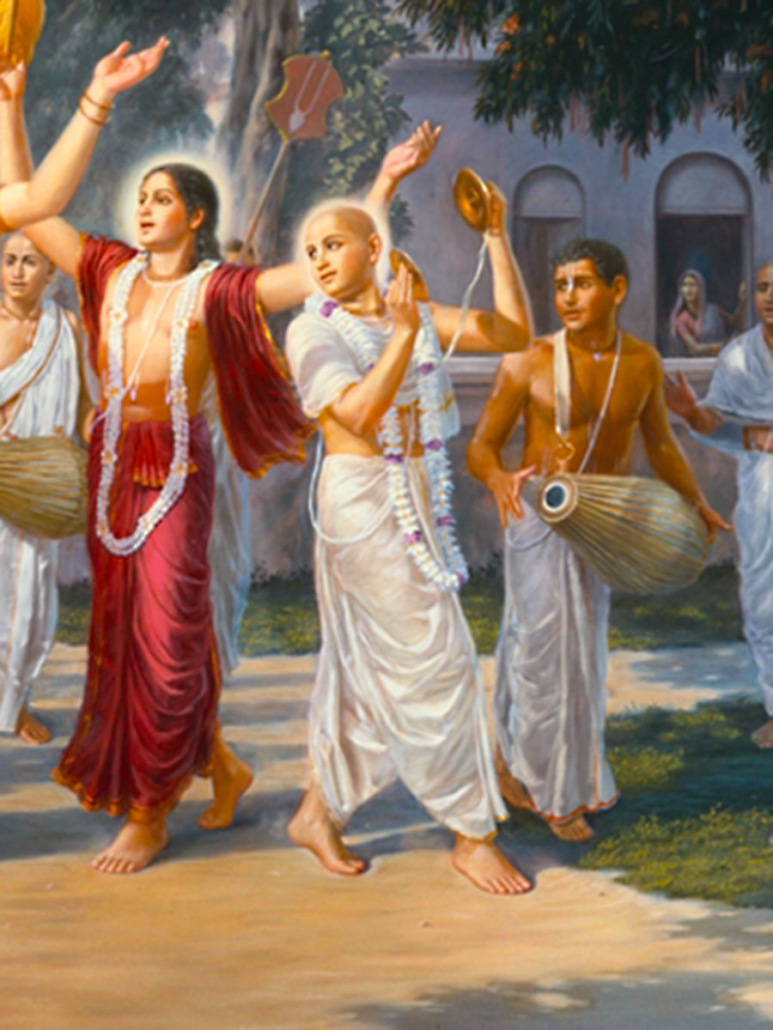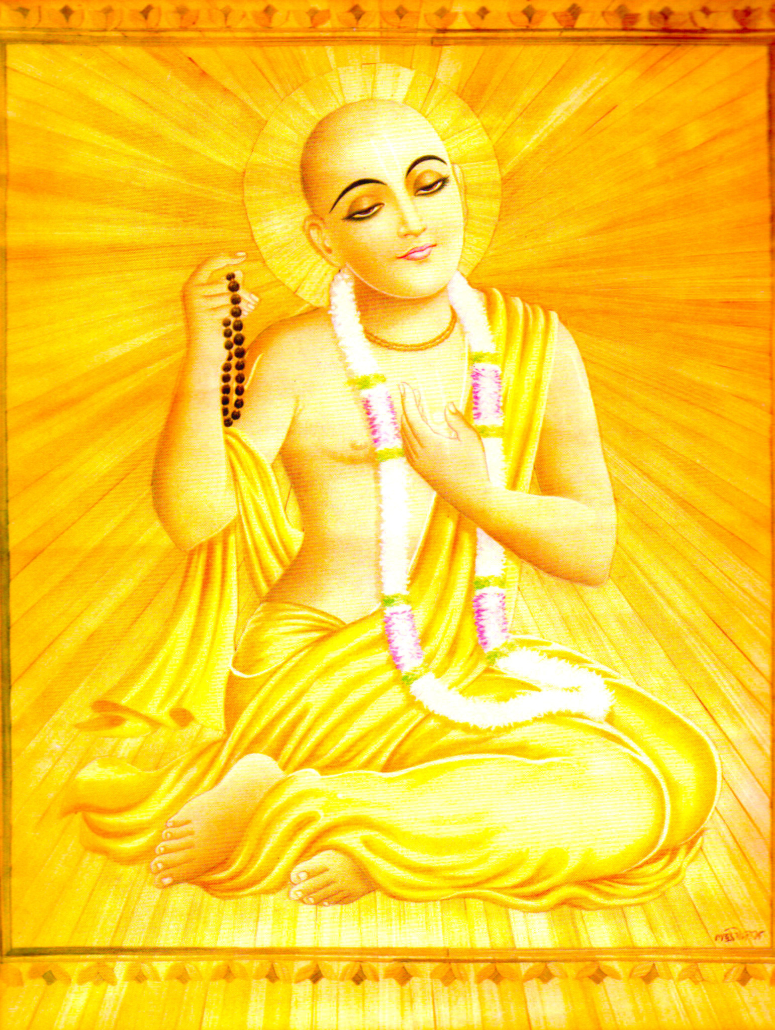Mahanidhi Madan Gopal Das
The Srimad Bhagavatam says that after 64 days and nights of lessons from Their Guru Sri Sandipani Muni, Bhagavan Sri Krishna and Baladeva fully mastered the 64 arts, tau sanjagrhatuh ahah ratraih catuh shashtya kalah. (Srimad Bhagavatam 10. 45.35-36)
Jayadeva Goswami and the six Goswamis often glorify Srimati Radharani with the name Kalavati, which means that Sri Radha is fully skilled in all the 64 traditional arts. All the Vraja-gopis learn all the arts and sciences from Vrindavaneshvari Sri Radha.
In Radha Krishna Ganoddesha Dipika, Sri Rupa Gosvami describes the special talents of Srimati Radharani’s ashta-sakhis.
Lalita-sakhi:
Lalita is expert in bringing Radha-Madhava together and inciting Their conjugal battles. To support Radha’s cause she sometimes offends Sri Madhava. In Krishna conflicts, she leads the charge, and when needed Lalita discharges the most outrageous and haughty retorts. She holds Radha-Madhava’s flower umbrella, adorns Them with flowers, decorates Their resting bower, and oversees all the sakhis and manjaris of Vraja.
Visakha:
A very clever messenger, Visakha is the master of joking, laughter and merriment. Being expert in amorous diplomacy, Visakha often counsels Radha and Krishna. Visakha can conciliate an angry lover, bribe him and quarrel with him as needed to facilitate Radha Govinda’s joyful play.
Citra-sakhi:
Citra can detect hidden intentions in a love letter. She is a master cook who knows tastes just by glancing. She strikes water pots to make amazing music. Citra devi knows astronomy, astrology, raising domestic animals, gardening, collecting herbs and making tasty tangy nectar drinks.
Indulekha-sakhi:
She knows palmistry, snake charming, stringing necklaces, gemology and weaving cloth. Indulekha carries messages between the divine lovers and she knows Their secrets. She tastefully presents perfect ornaments and garments to Radha-Madhava.
Campakalata:
She is expert in persuasion, thwarting Radha’s rivals and at collecting forest fruits, roots and flowers. She is an artistic potter and a famous sweet maker. She protects all the trees, creepers and bushes of Vrndavana.
Rangadevi:
When Radha meets Krishna, Rangadevi provides unlimited gestures, words and jokes. She is a diplomat, a logician, and she knows a mantra to attract Krishna. For Lila Yugala’s pleasure, Ranga produces and offers perfumes, cosmetics, aromatic incense, coal for heating and wields fans for cooling. She is also an adept “animal trainer” in the sense that she can control the wild lions and deer in the forests of Vraja.
Tungavidya-sakhi:
She knows the eighteen branches of Vedic knowledge, politics, and rasa-sastras; teaches music, singing; plays the vina with great expertise, and choreographs all the dances and music at the rasa dance. She is an expert meeting arranger, and drinking water collector.
Sudevi-sakhi:
Sudevi is Radha’s hairdresser, masseuse, and make up artist. Sudevi cares for the birds and bees, and trains the parrots and roosters to sing and fight. She knows the arts of horticulture, starting fires, reading omens, forming leaf spittoons, playing music on bells and decorating couches. Sometimes Sudevi adopts a disguise to spy on Radha’s rivals.
Radha’s sakhis each know a variety of talents and skills which they display to nourish Sri Krishna’s relish of madhurya rasa. Sri Radha personally arranges for every newcomer manjari i.e. sadhana siddha manjari to learn all the traditional arts and sciences from Her trusted and talented sakhis. Thus Radha makes the nava dasi manjari qualified to serve Her and Her beloved Shyama.
In Sri Sankalpa Prakasha Stotram, Sri Raghunatha Dasa Goswami describes how a sadhana siddha manjari or kinkari maidservant of Srimati Radhika approaches different sakhis beginning with Sri Radha Herself to learn the various fine arts. From Sri Radha, the enthusiastic, excited and humble new manjari will learn how to write poems, plays, riddles and master the vina.
Visakha-sakhi teaches the newcomer manjari the arts of telling clever fragrant jokes, and singing sweet songs to entertain Radha-Madhava, especially during the Rasa dance. From the “sweet hands” of Campakalata sakhi, the nava-dasi, new manjari, learns the science of flavorful cooking to please the Playful Pair with a nectar conquering midday feast at Radha-kunda!
Citra sakhi happily teaches the new dasi the art of body painting to serve Yugala Kishora, especially after their exuberant amorous encounters in the bower cottages. Tungavidya sakhi will train the new manjari in 18 different arts and sciences including the rasa, niti, natya, and sangita shastras.
Indulekha will patiently instruct the new maidservant, nava dasi, to string beautiful necklaces of pearls, jewels, flowers and gunja beads to decorate Sri Sri Radha and Krishna at Radha-kunda during Their blissful midday pastimes, madhyahna-lila.
From Rangadevi the new manjari will learn to dance so perfectly that she will spin and swirl in step with Sriji and Shyama during the Rasa dance while simultaneously putting betel-leaves in Their mouths! From Sudevi, nava dasi manjari will learn the art of throwing dice so nicely that just by eye signals she will help Radhika defeat Krishna in playing dice.
The following description of the 64 arts comes from a purport of Brahma-samhita (v.37): While reading and reflecting upon these amazing skills, one should think that Sri Radha is the self-manifest origin of all these talents in their complete original form. Srimati Radharani has bestowed these arts upon Her dearest sakhis.
When one becomes spiritually perfect he/she will enter the prakata-lila, manifest pastimes, of Radha Govinda Yugala in Bhauma Vrindavana. Then as a sadhana siddha in manjari svarupa as Sri Radha’s loyal dasi or kinkari one will learn all these arts from various sakhis. May all the devotees dive deep into the unlimited ocean of Radha-Madhava’s sweet madhurya lilas which are full variety, excitement, fulfillment and never-ending loving bliss.
The Sixty-four Arts
(1) gīta—art of singing, composing songs, and articulating different melodies, notes, accents and meters.
(2) vādya—art of playing on the four types of musical instruments (wind, strings, percussion, metallic cymbals).
(3) nṛtya—art of dancing and moving the limbs in various symbolic expressions. It includes dancing with different rhythms, songs and melodies.
(4) nāṭya—art of writing theatrical dramas.
(5) ālekhya—art of drawing, calligraphy and painting pictures. It includes all forms from simple village arts up to the highest perfectional stage of masterful painting.
(6) viśeṣakacchedya—art of painting the face and body with various dots and designs of colored unguents and cosmetics.
(7) taṇḍula-kusuma-balī-vikāra—art of preparing auspicious offerings for worship with rice and flowers. It includes making paintings on the floor or ground with liquid paste of rice flour.
(8) puṣpāstaraṇa—art of making comfortable resting places by spreading flowers on the ground.
(9) daśana-vasanāṅga-rāga—art of coloring teeth, clothing and bodily limbs with cosmetics like saffron.
(10) maṇi-bhūmikā-karma—art of inlaying floors, courtyards and pathways with colorful mosaics of precious jewels.
(11) śayyā-racana—art of preparing different types of beds, complete with carpets, cushions, pillows, cloth coverings and decorations like tassels.
(12) udaka-vādya—art of making music in water. The cupped palms splash downward to produce the thumping sound of kettledrums, or the hand splashes sideways back and forth to simulate cymbals. Sometimes this art is said to be playing different pots filled with varying levels of water to produce melodious tunes.
(13) udaka-ghāta—art of splashing with water, and storing water in cisterns and reservoirs.
(14) citra-yoga—art of trimming, decorating and hanging pictures.
(15) mālya-grathana-vikalpa—art of stringing necklaces and weaving flower garlands for various uses.
(16) śekharāpīḍa-yojana—art of setting a crown upon the head, including turbans, and top-knots of flowers.
(17) nepathya-yoga—art of putting on costumes in the dressing room for theatrical performances. Includes scenic stage arrangements.
(18) karṇapātra-bhaṅga—art of decorating earlobe with flower or leaf-ornaments, and painting ornamental figures.
(19)sugandha-yukti—art of preparing and applying aromatics and perfumed cosmetics of various kinds. Includes sprinkling sandalwood pulp and water to produce a nice fragrance.
(20)bhūṣaṇa-yojana—art of beautifying the body and limbs with specialized types of ornaments and jewelry.
(21) indra-jāla—art of presenting stage music, illusions and jugglery.
(22)kauchumāra-yogā—art of appearing in various disguises.
(23) hasta-lāghava—art of sleight of hand.
(24) citra-śākāpūpa-bhakṣya-vikāra-kriyā—art of preparing varieties of salad, bread, cake and delicious food.
(25) pānaka-rasa-rāgāsava-yojana—art of preparing nectar drinks and tinging draughts with red color.
(26) sūcī-vāya-karma—art of needleworks, weaving, embroidery and tailoring.
(27) sūtra-krīḍā—art of manipulating puppets with strings.
(28) vīṇā-ḍamuraka-vādya—art of playing on lute and small x-shaped drum.
(29)prahelikā—art of making and solving riddles. (29-a) pratimālā—art of reciting verse for verse as a trial for memory or skill.
(30) durvacaka-yoga—art of skillfully uttering tongue-twisters that are difficult for others to repeat.
(31) pustaka-vācana—art of clearly and quickly reading and reciting books, including techniques of chanting and intoning.
(32)nāṭikākhyāyikā-darśana—art of enacting short plays and anecdotes.
(33) kāvya-samasyā-pūraṇa—art of completing verses after hearing only three lines. Includes solving crossword and various puzzles. This is usually played at the risk of losing a stake or paying a penalty.
(34) paṭṭikā-vetra-bāṇa-vikalpa—art of manufacturing armaments such as shield, staffs, bows and arrows.
(35) tarku-karma—art of making thread with a spinning wheel.
(36) takṣaṇa—art of wood-cutting and carpentry.
(37) vāstu-vidyā—art of architecture and engineering.
(38) raupya-ratna-parīkṣā—art of testing the authenticity of silver and jewels.
(39) dhātu-vāda—art of metallurgy and alchemy.
(40) maṇi-rāga jñāna—art of using dyes to alter the color of precious gemstones.
(41) ākara jñāna—art of mineralogy.
(42) vṛkṣāyur-veda-yoga—art of gardening and crossbreeding plants and trees for the purpose of obtaining Ayur Vedic medicines.
(43) meṣa-kukkuṭa-lāvaka-yuddha-vssidhi—art of training rams, cocks, and grouse to fight for sport.
(44) śuka-śārikā-prapālana (pralāpana)—art of teaching male and female parrots to speak and hold conversations with people.
(45) utsādana—art of skin care. Includes cleaning the skin with perfumed lotions, and using ointments for healing.
(46) keśa-mārjana-kauśala—art of expertly arranging the hair, including coloring and curling it in various ways.
(47) akṣara-muṣṭikā-kathana—art of speaking silently with sign language.
(48) mlecchita-kutarka-vikalpa—art of fabricating languages spoken in the indistinct ungrammatical manner of barbarians.
(49) deśa-bhāṣā-jñāna—art of knowing provincial dialects.
(50) puṣpa-śakaṭikā-nirmiti-jñāna—knowledge of building miniature carts with flowers.
(51) yantra-mātṛkā—science of drawing mystical diagrams for worship or for projecting powers.
(52) dhāraṇa-mātṛkā—art of preparing potent amulets worn for protection or other purposes.
(53) samvācya—art of conversation. Sometimes called saṁpātyam—art of splitting hard substances such as diamonds into smaller pieces
(54) mānasī kāvya-kriyā—art of composing poetry within the mind.
(55) kriyā-vikalpa—art of designing the performance of rites and ceremonial functions. Also the art of good management, that of accomplishing many things at once. Includes fortelling events by studying omens.
(56) chalitaka-yoga—art of playing tricks and practical jokes.
(57) abhidhāna-koṣa-cchando-jñāna—art of use dictionaries, word-usage, poetic meters, and lexicography.
(58) vastra-gopana—art of concealing the true nature of cloth, making it appear as made of a different or superior texture. For example, one may make coarse cotton appear as silk.
(59) dyūta-viśeṣa—art of knowing specific forms of gambling.
(60) ākarṣa-krīḍā—art of playing with magnet and magnetic phenomena. Includes hypnotism and the power of attracting others.
(61) bālaka-krīḍanaka—art of playing children’s games.
(62) vaināyikī vidyā—art of enforcing discipline by employing mystical charms. Includes understanding another’s psychic movements in order to influence their mind and induce them to act according to one’s own wishes.
(63) vaijayikī vidyā—art of gaining victory.
(64) vaitālikī vidyā—knowledge of artfully reciting the glories of great personalities. Includes knowing how to properly offer respects and compliments to others.
Sri Radha’s sixty-four arts ki jai! Sakhis Training Manjaris ki jai!
Jaya Jaya Sri Radhe!



